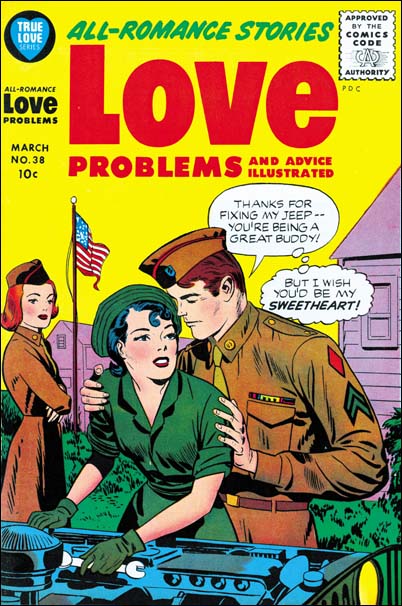
Love Problems #38 (March 1956) by Jack Kirby
Previously in the End of Simon and Kirby we saw Simon and Kirby start Mainline, their own publishing company. When unfortunately Mainline failed they turned to the poorly paying Charlton to publish the same titles for a couple of issues. Then Harvey Comics would release three issues of Western Tales that contain some new Simon and Kirby material. Work for Prize would now be limited to three bimonthly romance titles.
Starting in December 1955 Jack Kirby would pencil pretty much all of the contents for these Prize romances. Prior to that the Prize romance titles were being done by S&K studio freelance artists including the usual suspects Bill Draut, Mort Meskin and John Prentice. When Kirby took over these titles, what happened to these artists? Well even though I describe these issues as all Kirby romances they did include 7 non-Kirby stories. But 7 stories is not much for an entire year. For Mort Meskin the December issue of Young Love (#68) was his last for Simon and Kirby productions. Judging from the GCD, Mort would return to DC working mostly in their horror genre. We have already seen that Bill Draut would give Kirby a hand in inking for at least some of the all Kirby issues. Draut would also, along with John Prentice, appear in Harvey romances.
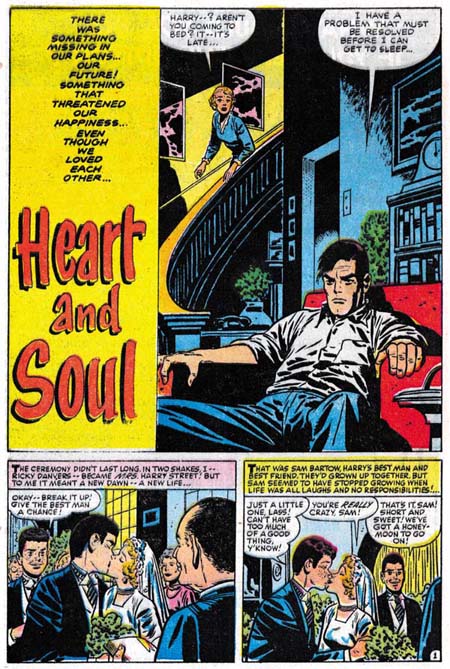
True Bride-To-Be #19 (August 1956) “Heart and Soul” by Bill Draut
Although Harvey specialized in comics for the very young, he also had five romance titles at this time. The interiors or these titles are very formalistic. Each would start with a contents or introduction page. The stories would all be relatively short. Most titles would consist of stories that are exactly 5 pages long and in addition there would be some single page features. A title may occasionally deviate by including a 7 page story. Unfortunately there seems to have been a house rule about not signing any of the work. This makes determining who the artists were difficult without reference to other publications. Fortunately work by Draut and Prentice are rather distinctive. In the end Harvey romances look very different from Simon and Kirby productions. Personally I enjoy S&K productions even when they do not include Kirby pencils. S&K productions have their own house style, but it still allows for a lot more variations between stories. Harvey romances seem to offer a much too uniform look.

True Bride-To-Be #20 (October 1956) “Homecoming” by John Prentice
I have a word of caution to give about the following analysis. I have examined all the Harvey issues with Kirby covers but beyond that my access it spotty. I have augmented this using Heritage auction records but of course that can not be considered complete either. I should add that Heritage are often wrong in their attributions, a good portion of the art that they said was done by Draut or Prentice was done by other artists. Unfortunately the resulting data is still too incomplete for the earlier period but seems sufficient for the latter part of my story.
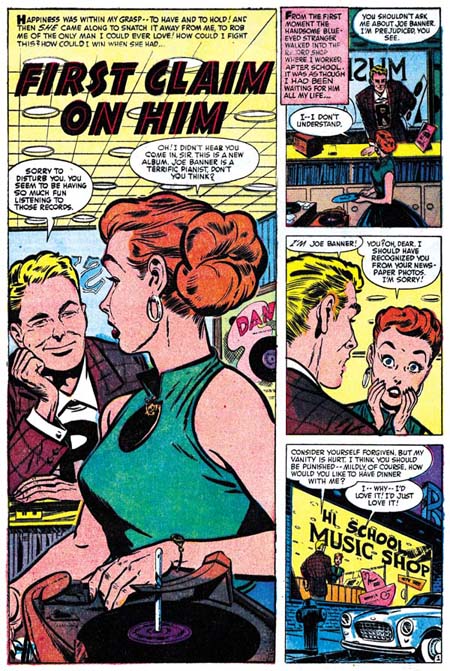
Hi-School Romance #60 (February 1956) “First Claim On Him” by Bob Powell
I was surprised to see that Bill Draut actually shows up at Harvey rather early in Love Problems and Advice #23 (September 1953). He is also in Hi-School Romance #33 (October 1954). But as I said, my early data is incomplete and I have no idea how often he appears. The next occurrence I know of is February 1956 after which he starts showing up commonly. My first record of John Prentice starts in January. I should add that not every issue has Bill or John and when they are present they only have one story each. Jack Kirby starts providing some covers and an occasion introduction page. Neither Draut nor Prentice did any covers although they did do some introduction pages. On the other hand Kirby did not do any stories. So far I have not detected any of the other former S&K freelance artists among these Harvey romances. Which is too bad because I am not overly fond of many of the artists in these titles. With one exception, Bob Powell has a long history of work for Harvey comics and his romance art here is just superb. The work that Draut and Prentice did for these Harvey romances seems consistently quite nice. I wish I could say the same thing about Kirby’s covers. They seem to range from the exceptionally beautiful to the rather dull.

True Bride-To-Be Romances #17 (April 1956) by Jack Kirby
Some people have expressed to me their doubts about whether some of these covers really were done by Jack. The composition used are rather static. But that is not surprising since dynamic action is not a requirement for romance covers, in fact it can be detrimental. Unfortunately that means some typical Kirby features cannot be relied on here for attribution, such as Jack’s exaggerated perspective. Kirby has his own nuances when handling figures but much of these can be lost depending on the inker and some of the inking for these covers is poor. My opinion is that the Jack Kirby Checklist is correct about most of the Harvey romance covers it attributes to Jack. I disagree with the Checklist only about Hi-School Romance #73 (March 1958), its a nice cover but the layout does not look correct for a Kirby and the nuances do not seem right either despite what looks like pretty good inking.
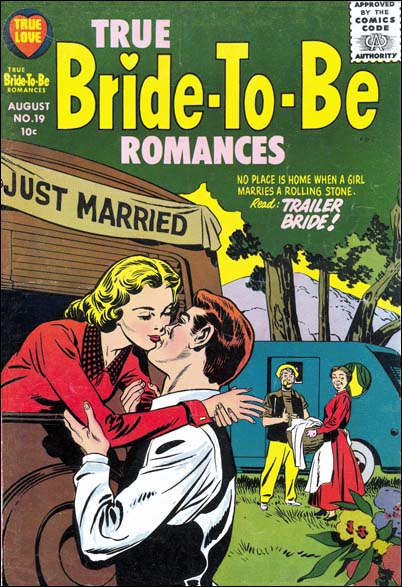
True Bride-To-Be Romances #19 (August 1956) by Jack Kirby
I believe that Jack penciled 18 romance covers for Harvey. These covers were done during the same time period as the all Kirby Prize romance comics (see last chapter). I believe that Jack did all the spot inking for those Prize romances. But inking for the Harvey covers does not look the same. Part of the difference is due to the fact that the S&K shop style of coarse crosshatching (like the “picket fence” or the rows of short dashes) is not used on any of the Harvey covers. This is not surprising since such heavy crosshatching would seem to conflict with the house style of the Harvey romances. Perhaps in compensation on some Harvey covers tonal areas are sometime achieved by the use of finer parallel brush strokes. Finer then the S&K shop inking, but coarser then what could be achieved with a pen. Both the Prize and Harvey covers are similar in having less spotting that results in lighter covers. Also in both cover groups, darker areas are sometimes achieved by flooding a larger area with ink. As part of sparer spotting, both Harvey and Prize covers have sleeves where the folding is concentrated at the junction with the chest and also in the elbow region. But on some of the Harvey covers the folding in the elbow region look very unnatural especially since some of the folds take unusual paths (see True Brides-To-Be #19 above). This convinces me that at least two artists did the spot inking on different Harvey covers. To complicate things even more, at least one of the covers (First Love #70 November 1956) appears to have had two artists doing the spotting. The first one did the spotting generally using fine parallel brush strokes. The second artist then touched up over these finely lined parts of the man’s hair and his sleeve with much coarser brush work.
The last Kirby cover for a Harvey romance occurred in December 1956, the same month that the all Kirby romances for Prize ends. The finish for work by Bill Draut and John Prentice for these Harvey romances seems to be May 1957. Here my references are more complete and I do not expect this date is too far off. The question remains what was the working arrangement here? Well the romances done during this period of about a year show no significant difference then those that preceded or followed. Whatever they were, they were not Simon and Kirby productions. I have a folder of work that Joe Simon did as an editor for Hi-School Romance Date Book #4 from 1963 (I do not think that this particular issue was ever published). I believe that Joe started doing such editorial work for Harvey in 1956 to help his financial situation after the failure of Mainline early in 1955. The various post-Mainline Simon and Kirby projects just did not provide enough money. As editor, not producer, Joe would continue to use the same artists and writers that Harvey had already had. Joe could however give some jobs to Bill Draut and John Prentice who lost work particularly when the all Kirby romances started. Jack was busy with those Prize romances, but not too busy that he could not provide Joe with some covers.

Black Cat Mystic #58 (September 1956) “Gismo”, by Jack Kirby
But if Simon was doing editorial work for Al Harvey, he still was pitching new work. At least that is how I interpret Harvey’s Black Cat Mystic #58. All of the contents of this horror/science fiction anthology were penciled by Kirby. When I outlined for myself the The End Of Simon & Kirby, I was unsure what chapter I should put this comic. Truth be told, if I had to do it over again I would place Black Cat Mystic #58 after my discussion about the Western Tales issues in chapter 4. Although the cover date for #58 is rather late, the inking seems to bridge the gap between the more classical S&K shop style in the Western Tales and the new inking manner found in the all Kirby romances. One splash (see above) exhibits the shop manner of coarse crosshatching (“picket fence”) and the introduction page (see below) exhibits robust spotting. Other stories are inked more like the all Kirby romances with more limited spotting and flooding used in the larger dark areas. Another clue to the earlier date for the art is the original art for the introduction page is done on the thick illustration board typically used by the S&K studio, while all the Harvey romance covers by Kirby that I have seen were done on thinner Strathmore.
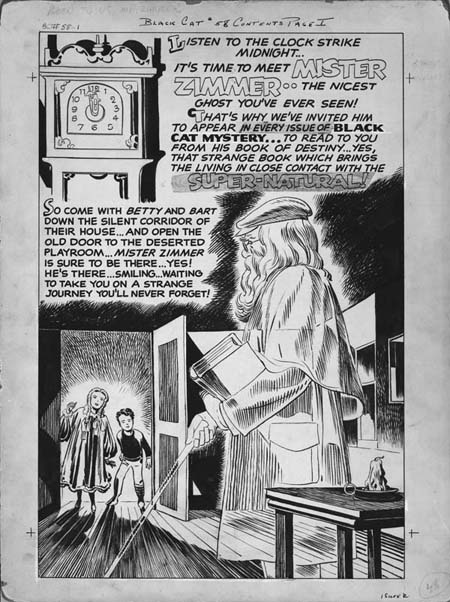
Black Cat Mystic #58 (September 1956) introduction, original art by Jack Kirby
On the introduction page we meet Mr. Zimmer, a ghost who tells two youngsters stories and takes them on adventures. In fact that is the premise of the story “Read To Us, Mr. Zimmer”. The way Mr. Zimmer is presented makes it seem that this issue would be the start of a new series. But as before with Western Tales, Harvey seemed willing to publish Simon and Kirby concepts, but he just did not seem to have enough interest to get them out on a timely basis. The next issue of Black Cat Mystic would not be released until a year later (September 1957).

